Festival Museum Nusantara adalah sebuah Festival yang diselenggarakan oleh Taman Mini Indonesia Indah dalam rangka meningkatkan kembali rasa kebanggaan dan kecintaan kita sebagai bangsa Indonesia akan warisan budaya Indonesia yang harus dilestarikan oleh generasi saat ini dan mendatang. Upaya yang sangat bagus dilakukan oleh pihak Taman Mini Indonesia Indah yaitu pelaksanaan Festival Museum Nusantara 2010 yang diresmikan pada Jum'at, 8 Januari 2010 sebagai implementasi atas pencanangkan Tahun Kunjung Museum oleh Pemerintah Indonesia pada 30 Desember 2009 yang lalu. Disamping itu juga, Taman Mini Indonesia Indah menyelenggarakan Kontes SEO untuk para blogger, untuk turut berpartisipasi dalam mempromosikan kunjungan ke museum-museum yang ada di Taman Mini Indonesia Indah.
Dengan Festival Museum Nusantara ini, Taman Mini Indonesia Indah berkeinginan meningkatkan apresiasi dan kepedulian masyarakat terhadap warisan budaya bangsa Indonesia yang masih bertahan, termasuk hasil karya, tradisi, sampai pada pengenalan adat istiadat.Museum merupakan wahana yang memiliki peran strategis terhadap penguatan identitas masyarakat dan bangsa dimana bangsa Indonesia memiliki keanekaragaman budaya dan masyarakat yang terlihat melalui aspek budaya, tradisi, adat istiadat, upacara, kesenian, dan benda-benda budaya yang dihasilkan sebagai warisan budaya yang tak ternilai harganya. Melalui museum, masyarakat dan pengunjung dapat menimba pengalaman, pengetahuan, dan informasi menarik sekitar kehidupan sebagai wujud kebudayaan dari masa lalu, kini, dan menjadi inspirasi pada masa depan.
Apa saja museum yang terdapat di Taman Mini Indonesia Indah dalam rangka "Kenali bangsa dengan mengunjungi museum-museum di Taman Mini Indonesia Indah” berikut cuplikan singkat yang berasal dari kemuseumyuk.com dan tamanmini.com, silahkan simak liputan berikut:
Festival Museum Nusantara
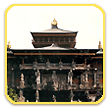 Gedung Museum Indonesia berarsitektur Bali tiga lantai dikembangkan dari filosofi tri hita karana, yang menjelaskan adanya tiga sumber kebahagiaan manusia, yakni hubungan dengan Tuhan, sesama manusia, dan lingkungan alam. Museum Indonesia menjalankan fungsinya melalui pameran tetap dengan tiga tema. Lantai I bertema Bhinneka Tunggal Ika, menampilkan pakaian adat dan pakaian pengantin secara lengkap yang meliputi 27 provinsi, sesuai dengan jumlah provinsi di Indonesia pada saat peresmiannya. Koleksi pakaian pengantin dan pakaian adatnya paling lengkap dan tidak dijumpai di museum lain di Indonesia, bahkan di dunia. Pameran keanekaragaman pakaian adat dan pakaian pengantin sekaligus merupakan cermin kemajemukan budaya masyarakat Indonesia, baik dilihat dari sisi agama, pakaian, kesenian, maupun adat istiadatnya.
Gedung Museum Indonesia berarsitektur Bali tiga lantai dikembangkan dari filosofi tri hita karana, yang menjelaskan adanya tiga sumber kebahagiaan manusia, yakni hubungan dengan Tuhan, sesama manusia, dan lingkungan alam. Museum Indonesia menjalankan fungsinya melalui pameran tetap dengan tiga tema. Lantai I bertema Bhinneka Tunggal Ika, menampilkan pakaian adat dan pakaian pengantin secara lengkap yang meliputi 27 provinsi, sesuai dengan jumlah provinsi di Indonesia pada saat peresmiannya. Koleksi pakaian pengantin dan pakaian adatnya paling lengkap dan tidak dijumpai di museum lain di Indonesia, bahkan di dunia. Pameran keanekaragaman pakaian adat dan pakaian pengantin sekaligus merupakan cermin kemajemukan budaya masyarakat Indonesia, baik dilihat dari sisi agama, pakaian, kesenian, maupun adat istiadatnya.2. Museum Asmat

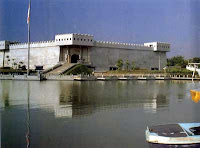
Museum Keprajuritan Indonesia berbentuk benteng bersegi lima yang dikelilingi perairan. Perairan sekeliling benteng ini menggambarkan negara kepulauan dengan doktrin Wawasan Nusantara. Misinya adalah melestarikan bukti dan rekaman sejarah perjuangan bangsa pada masa-masa perjuangan sejak abad ketujuh sampai abad kesembilanbelas. Oleh karena itu setiap segi bangunan dan benda yang ditampilkan memiliki makna perlambang. Gerbang utama berbentuk model bangunan abad keenambelas, mencerminkan sifat keterbukaan dan keramahtamahan rakyat Indonesia. Di setiap sudut bangunan terdapat menara pengintai atau bastion, menyiratkan kewaspadaan nasional. Dua kapal tradisional—yaitu kapal Banten dan kapal Pinisi dari Sulawesi Selatan—bersandar di danau, melambangkan kekuatan maritim dari barat sampai ke timur.
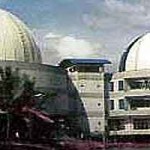
Salah satu museum sains yang menyajikan koleksi peragaan tentang energi dan listrik, adalah Museum Listrik dan Energi Baru (Museum LEB). Rancang-bangunnya mengacu pada konsep arsitektur berbentuk tapak "Struktur Atom”, yaitu satu proton dikelilingi tiga elektron, diaplikasikan dalam bentuk Anjungan Listrik yang dikelilingi tiga bangunan lain, yakni Anjungan Energi Baru, Anjungan Energi Fosil, dan Anjungan Energi Konvesional.
Sebagai wahana pendidikan dan rekreasi, Museum LEB mengemban fungsi menyampaikan informasi teknologi kelistrikan dan energi, baik dari sejarah perkembangan teknologi, aplikasi energi di Indonesia dari masa ke masa, maupun semangat inovasinya kepada generasi mendatang. Tata pamerannya memungkinkan pengunjung diajak mengenal segala aspek listrik dengan alur yang jelas dan runtut, penyajian yang interaktif karena didukung teknologi komputer (audiovisual).
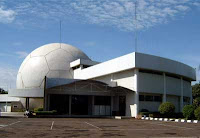
Bentuk bangunan Museum Olahraga sungguh unik, yakni berbentuk bola menghadap ke arah Teater Keong Emas. Berdiri di atas tanah 1,5 hektar dengan luas bangunan 3.000 m2 , museum ini bertujuan memberikan pemahaman masyarakat mengenai pentingnya olah raga bagi kesehatan badan. Lobby lantai dasar menampilkan motto yang mencerminkan nilai hakiki olahraga, antara lain sportivitas dan perjuangan. Pameran meliputi sejarah olahraga antarbangsa, menampilkan perjuangan bangsa Indonesia dalam mengikuti kegiatan olahraga di dunia internasional, seperti Olimpiade Helsinki dan Asian Games; tokoh olahraga, menampilkan para pejuang olahraga yang telah mengharumkan nama bangsa di bidang keolahragaan dan para tokoh yang berkecimpung dalam bidang olahraga; sejarah olahraga nasional, menampilkan sejarah berdirinya stadion pertama Indonesia dan pelaksanaan PON I tahun 1948 di Solo; serta keberhasilan tim Everest, menampilkan perjuangan Tim Kopassus dalam menaklukkan Gunung Himalaya dan Tim Dewaruci yang menampilkan maket kapal Dewaruci.

Museum Telekomunikasi berada di bagian depan kawasan TMII berdampingan dengan Museum Olah Raga dan Bayt al-Quran di dekat pintu utama. Ciri khas museum ini beratap kubah warna biru dengan keberadaan di depannya sebuah Monumen Sumpah Palapa Maha Patih Gajah Mada yang berdiri tegak sambil mengacungkan keris. Adegan ini mengingatkan pada satelit komunikasi pertama Indonesia yang diberi nama Palapa, sesuai jiwa Sumpah Palapa menyatukan nusantara. Gedung museum meliputi bangunan induk untuk ruang pameran dan pengelolaan serta ruang penerima tamu di bagian depan. Museum Telekomunikasi memamerkan berbagai koleksi dan informasi mengenai perkembangan pertelekomunikasian di Indonesia pada masa sebelum-masa perang-awal kemerdekaan, Orde Baru, dan masa depan telekomunikasi dunia, termasuk alat komunikasi dari masa ke masa. Alat telekomunikasi pra elektrik antara lain meliputi alat komunikasi tiup, kentongan/gendering, bedug, gong, dan lonceng. Alat telekomunikasi masa elektrik antara lain telegraph morse, sentral telepon manual lokal baterai, dan diorama pemancar radio perjuangan YBJ-6.

Rancang-bangun Museum Penerangan berbentuk bintang bersudut lima yang melambangkan Pancasila dan lima unsur penerangan. Museum ini mengumpulkan, mempelajari, menggelar, dan merawat objek sejarah penerangan dan komunikasi sekaligus sebagai media komunikasi massa keenam setelah tatap muka, radio, TV, film, dan pers.
Di halaman depan terdapat tugu yang menyangga lambang penerangan "Api Nan Tak Kunjung Padam” dikelilingi oleh lima patung juru penerang serta air mancur, pertemuan air dari atas tugu dengan air yang memancar dari bawah, melambangkan hubungan timbal balik antara pemerintah, masyarakat, dan media massa. Bangunan terdiri atas tiga lantai berbentuk silinder, mencitrakan kentongan sebagai unsur penerangan tradisional, menyangga menara antena sebagai unsur modern.
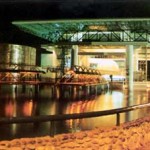
Museum Minyak dan Gas Bumi "Graha Widya Patra” (Gawitra) terletak di bagian timur TMII berdekatan dengan Taman Burung dan Museum LEB. Pembangunan Museum Migas menandai peringatan 100 tahun industri minyak dan gas bumi Indonesia, merupakan sumbangan masyarakat perminyakan Indonesia demi melestarikan dan mewariskan nilai-nilai juang kepada generasi penerus untuk peningkatan ilmu dan teknologi. Gedung utama berbentuk anjungan lepas pantai dengan dua bangunan pendukung berbentuk gilig menyerupai tangki minyak, disebut Anjungan Eksplorasi dan Anjungan Pengolahan. Ruang pamer terdapat di gedung utama dan di anjungan eksplorasi. Pameran di gedung utama mengenai sejarah industri perminyakan. Di ruang ini terdapat Teater Minyak yang memutar film pendek dan multislide mengenai asal-mula serta hasil pengolahan minyak dan gas bumi di Indonesia. Selain itu terdapat ruang untuk pameran berbagai benda dan bahan mengenai minyak dan gas bumi yang ada di sekitar kita.

Museum Transportasi merupakan lembaga milik Departemen Perhubungan dengan maksud mengumpulkan, memelihara, meneliti, memamerkan bukti sejarah dan perkembangan transportasi, serta peranannya. Tujuannya memberikan informasi dan tambahan pengetahuan kepada para pengunjung mengenai transportasi dan sejarah perkembangan teknologi transportasi sekaligus sebagai tempat rekreasi yang edukatif. Pameran diselenggarakan di dalam dan di luar ruang. Pameran di dalam ruang dibagi dalam beberapa ruangan yang seolah-olah merupakan bangunan tersendiri, disebut modul; terdiri atas modul pusat, modul darat, modul laut, dan modul udara; baik dengan benda asli, tiruan, miniatur, foto, maupun diorama. Modul pusat menggambarkan keberadaan transportasi tradisional masa lampau, mencakup transportasi darat dan laut dari berbagai daerah di Indonesia, berupa alat transportasi sederhana dengan menggunakan tenaga manusia, hewan, atau angin; antara lain cikar, andong, bendi, becak, perahu layar.

Museum Fauna Indonesia "Komodo” dan Taman Reptilia menampilkan pesona satwa langka dalam bentuk awetan dan reptilia hidup. Arsitektur bangunannya mengambil bentuk komodo, satwa yang hanya hidup di Pulau Komodo, Nusa Tenggara Timur, berdiri di atas lahan seluas 10.120 m² dengan luas bangunan 1.500 m². Tema pameran adalah keanekaragaman satwa di Indonesia, dari barat sampai timur, dan dari pantai sampai pegunungan, ditata dalam dua lantai.
Koleksi lantai I berupa berjenis-jenis binatang mamalia dan reptilia lengkap dengan kondisi lingkungan alamnya. Jenis-jenis yang hampir mengalami kepunahan ditampilkan, antara lain harimau, gajah dan beruang. Di dalam vitrin-vitrin disajikan berbagai macam kupu-kupu yang terdapat di seluruh Indonesia; berjenis keong, kerang, kepiting, dan udang; serta binatang beruas, meliputi kaki seribu, laba-laba, dan kala jengking.Koleksi lantai II berupa berjenis-jenis burung yang diopset dan ditata sesuai dengan habitatnya, meliputi yang hidup di laut, pantai, rawa, persawahan, lapangan, perkebunan, dasar rimba, hutan, dan pegunungan dengan daerah asal Sumatera, Kalimantan, Jawa, Bali, Nusa Tenggara, Sulawesi, Maluku, dan Papua.Taman Reptilia yang menghadirkan koleksi reptilia hidup dibangun di sekitar gedung museum pada tanggal 20 April 2001. Pengunjung dapat mengenali satu persatu satwa unik tersebut mulai dari komodo, biawak, kadal, ular berkaki, ular sanca, king kobra, penyu, kura-kura leher ular, kura-kura buaya, kodok, buaya, iguana dan binatang reptil lainnya. Anak-anak yang memiliki rasa keingintahuan lebih dan selalu ingin memegang dapat bebas memegang dan bercengkerama dengan ular sanca di Taman Sentuh.
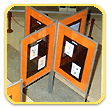
Museum Prangko dihiasi sejumlah ukiran dan patung gaya Bali dan Jawa, dikelilingi pagar tembok dengan dua pintu gerbang yang mengambil model dasar candi bentar. Di sayap kanan dan kiri terdapat dua bangunan yang luas masing-masing 402 m2, sayap kanan digunakan kantor pengelola dan tempat pertemuan, sedangkan sayap kiri untuk kantor pos. Museum ini memamerkan koleksi aneka prangko Indonesia dan luar negeri. Di depan pintu masuk berdiri patung Hanoman, yang dalam pewayangan dikenal sebagai dhuta dharmapembawa berita, misinya sama dengan tugas pos. Di samping kiri dan kanan pintu masuk ada dua lukisan gaya Bali karya pelukis Wayan Sutha yang merupakan cuplikan cerita pewayangan versi Bali, menggambarkan bahwa pada masa sebelum kertas dikenal seperti sekarang surat-menyurat menggunakan daun ‘ron’ tal.
12. Museum Pusaka
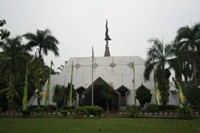
Museum Pusaka berada di jalur selatan di antara Museum Keprajuritan Indonesia dan Museum Serangga, berupa bangunan khas karena di atas atapnya terdapat bentuk keris yang menjulang. Museum ini bertujuan melestarikan, merawat, mengumpulkan, serta menginformasikan benda-benda budaya berupa senjata tradisional kepada generasi penerus agar merasa bangga terhadap bangsanya dan dapat dimanfaatkan bagi yang ingin melakukan studi dan penelitian mengenai senjata. Pada awalnya koleksi museum merupakan koleksi pribadi Mas Agung, kemudian dihibahkan oleh Sri Lestari Mas Agung kepada Ibu Tien Soeharto selaku ketua Yayasan Harapan Kita. Setelah ditambah dengan pembelian, Museum Pusaka memiliki koleksi senjata tradisional paling lengkap, mewakili 26 provinsi di Indonesia.
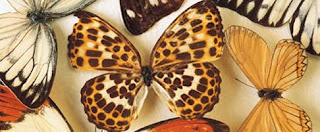
Pengurus Perhimpunan Kebun Binatang Seluruh Indonesia (PKBSI) dan Museum Zoologicum Bogoriense (MZB) dengan restu Ibu Tien Soeharto mendirikan Museum Serangga dengan tujuan mengenalkan keanekaragaman khasanah serangga serta merangsang keinginan dan kepedulian masyarakat terhadap peran dan potensinya di alam. Museum ini menempati areal seluas 500 m2 mengambil bentuk tubuh belalang dan diresmikan oleh Presiden Soeharto tanggal 20 April 1993. Pada tahun 1998, atas bantuan Dr. Soedjarwo melalui Yayasan Sarana Wana Jaya, menambah wahana baru berupa Taman Kupu beserta kebun pakan, kandang penangkaran, dan laboratorium yang diharapkan menjadi usaha penangkaran dan pelestarian kupu-kupu yang dilindungi dan langka. Kemudian tahun 2004 bertambah lagi sarana koleksi binatangnya selain serangga.
Museum Timor Timur terletak di sebelah utara Istana Anak-Anak Indonesia, menghadap ke selatan arah Museum Prangko. Semula Museum Timor Timur adalah Anjungan Daerah Timor-Timur yang dibangun tahun 1979 dan diresmikan 20 April 1980 oleh Presiden Soeharto. Setelah Provinsi Timor Timur berpisah dengan Negara Kesatuan Republik Indonesia dan membentuk negara sendiri, anjungan ini menjadi suatu monumen dan menjadi tanggung jawab pengelola TMII. Sebagai monumen, Anjungan Timor Timur kemudian berstatus museum di bawah pengelolaan Istana Anak Anak Indonesia.
Karya-karya unggulan para ulama dan intelektual muslim Nusantara sejak abad ke-17 sampai abad ke-20 yang bernilai historis dapat disaksikan di sini. Warisan budaya berupa mushaf, manuskrip Al Qur’an, arsitektur, seni rupa islami yang memiliki keindahan seni juga tersimpan. Bayt al Qur’an & Museum Istiqlal, memang menghadirkan pesona untuk direnungkan.
Bayt al Qur’an & Museum Istiqlal merupakan kesatuan dari dua lembaga yang berbeda namun dalam kesatuan konsep. Bayt al Qur’an, yang berarti rumah Al Qur’an, dengan materi pokok berupa peragaan yang berkaitan dengan Al Qur’an, sedangkan Museum Istiqlal menampilkan hasil-hasil kebudayaan Islam Indonesia.
Demikianlah cuplikan dari berbagai Museum yang ada di Taman Mini Indonesia Indah, yang dapat menjadi panduan rekan-rekan pembaca dalam berkunjung ke Museum di Taman Mini Indonesia Indah sebagai wujud dari peran serta kita sebagai bangsa Indonesia dalam rangka melestarikan budaya milik bangsa, serta sebagai bahan buat kita dalam menimba pengalaman, pengetahuan, dan informasi menarik sekitar kehidupan kebudayaan dari masa lalu, kini, dan menjadi inspirasi pada masa depan.
Ayo! kita galakkan mengenali bangsa dengan berwisata berkunjung ke museum-museum di Taman Mini Indonesia Indah.
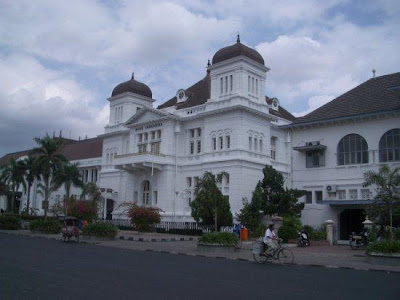
 In Indonesian, ancient temples are known as candi; thus "Borobudur Temple" is locally known as Candi Borobudur. The term candi is also used more loosely to describe any ancient structure, for example gates and bathing structures. The origins of the name Borobudur however are unclear, although the original names of most ancient Indonesian temples are no longer known. The name Borobudur was first written in Sir Thomas Raffles' book on Javan history. Raffles wrote about a monument called borobudur, but there are no older documents suggesting the same name. The only old Javanese manuscript that hints at the monument as a holy Buddhist sanctuary is Nagarakretagama, written by Mpu Prapanca in 1365. The name 'Bore-Budur', and thus 'BoroBudur', is thought to have been written by Raffles in English grammar to mean the nearby village of Bore; most candi are named after a nearby village. If it followed Javanese language, the monument should have been named 'BudurBoro'. Raffles also suggested that 'Budur' might correspond to the modern Javanese word Buda ('ancient') – i.e., 'ancient Boro'. However, another archaeologist suggests the second component of the name ('Budur') comes from Javanese term bhudhara (mountain).
In Indonesian, ancient temples are known as candi; thus "Borobudur Temple" is locally known as Candi Borobudur. The term candi is also used more loosely to describe any ancient structure, for example gates and bathing structures. The origins of the name Borobudur however are unclear, although the original names of most ancient Indonesian temples are no longer known. The name Borobudur was first written in Sir Thomas Raffles' book on Javan history. Raffles wrote about a monument called borobudur, but there are no older documents suggesting the same name. The only old Javanese manuscript that hints at the monument as a holy Buddhist sanctuary is Nagarakretagama, written by Mpu Prapanca in 1365. The name 'Bore-Budur', and thus 'BoroBudur', is thought to have been written by Raffles in English grammar to mean the nearby village of Bore; most candi are named after a nearby village. If it followed Javanese language, the monument should have been named 'BudurBoro'. Raffles also suggested that 'Budur' might correspond to the modern Javanese word Buda ('ancient') – i.e., 'ancient Boro'. However, another archaeologist suggests the second component of the name ('Budur') comes from Javanese term bhudhara (mountain). Mendut is a ninth century Buddhist temple, located in Mendut village, Mungkid sub-district, Magelang Regency, Central Java,Indonesia. The temple located about three kilometres east from Borobudur. Mendut, Borobudur and Pawon, all of which are Buddhist temples, are located in one straight line. There is a mutual religious relationship between the three temples, although the exact ritual process is unknown.
Mendut is a ninth century Buddhist temple, located in Mendut village, Mungkid sub-district, Magelang Regency, Central Java,Indonesia. The temple located about three kilometres east from Borobudur. Mendut, Borobudur and Pawon, all of which are Buddhist temples, are located in one straight line. There is a mutual religious relationship between the three temples, although the exact ritual process is unknown.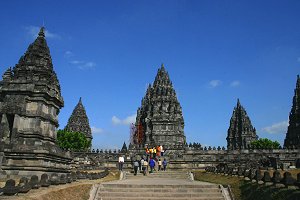 The ruins of Loro Jonggrang at Prambanan are the biggest Hindu ruins in Indonesia. Prambanan is the ninth century Hindu temple compound in Central Java, Indonesia, dedicated to Trimurti, the expression of God as the Creator (Brahma), the Sustainer (Vishnu) and the Destroyer (Shiva). The temple compound located approximately 18 km east of Yogyakarta city on the boundary between Yogyakarta and Central Java province.
The ruins of Loro Jonggrang at Prambanan are the biggest Hindu ruins in Indonesia. Prambanan is the ninth century Hindu temple compound in Central Java, Indonesia, dedicated to Trimurti, the expression of God as the Creator (Brahma), the Sustainer (Vishnu) and the Destroyer (Shiva). The temple compound located approximately 18 km east of Yogyakarta city on the boundary between Yogyakarta and Central Java province.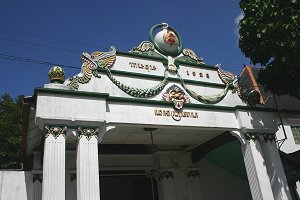 Keraton is the Javanese word for a royal palace. Its name is derived from ratu, which means "ruler" (king or queen). In Java, the palace of a prince is called puro or dalem. The general word to designate a palace is istana, as in Indonesian and Malay.
Keraton is the Javanese word for a royal palace. Its name is derived from ratu, which means "ruler" (king or queen). In Java, the palace of a prince is called puro or dalem. The general word to designate a palace is istana, as in Indonesian and Malay.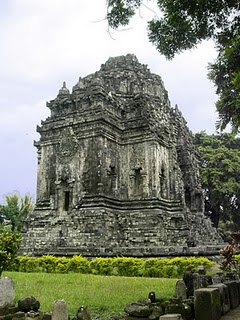 Kalasan Temple (also known as Candi Kalasan or candi Kalibening) is an 8th century Buddhist temple located 13 km east of the Yogyakarta on the way to Prambanan temple, right on south side of main road 'Jalan Solo' between Yogyakarta and Surakarta, Indonesia.
Kalasan Temple (also known as Candi Kalasan or candi Kalibening) is an 8th century Buddhist temple located 13 km east of the Yogyakarta on the way to Prambanan temple, right on south side of main road 'Jalan Solo' between Yogyakarta and Surakarta, Indonesia.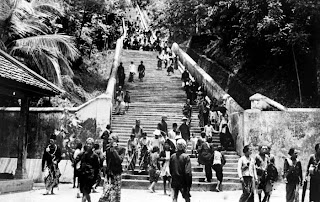 Imogiri (also Imagiri) is a royal graveyard complex in Yogyakarta, in south-central Java, Indonesia, as well as a modern village located near the graveyard in Bantul regency. Imogiri is a traditional resting place for the royalty of central Java, including many rulers of the Sultanate of Mataram and of the current houses of Surakarta and Yogyakarta Sultanate. The name Imagiri is derived from Sanskrit Himagiri, which means 'mountain of snow'. The latter is another name for Himalaya. The Royal Graveyard that preceded was Kota Gede. The graveyard was constructed by Sultan Agung of Mataram in the later years of his reign, probably in the 1640s. The graveyard is a significant pilgrimage ziarah site, particularly on significant dates in the Javanese calendar (such as Satu Suro, New Year's Day), and the Islamic calendar.
Imogiri (also Imagiri) is a royal graveyard complex in Yogyakarta, in south-central Java, Indonesia, as well as a modern village located near the graveyard in Bantul regency. Imogiri is a traditional resting place for the royalty of central Java, including many rulers of the Sultanate of Mataram and of the current houses of Surakarta and Yogyakarta Sultanate. The name Imagiri is derived from Sanskrit Himagiri, which means 'mountain of snow'. The latter is another name for Himalaya. The Royal Graveyard that preceded was Kota Gede. The graveyard was constructed by Sultan Agung of Mataram in the later years of his reign, probably in the 1640s. The graveyard is a significant pilgrimage ziarah site, particularly on significant dates in the Javanese calendar (such as Satu Suro, New Year's Day), and the Islamic calendar.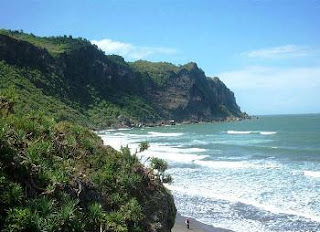 Parangtritis Beach is situated in Parangtritis Village about 17 km to the South of Bantul City. It is a plain beach, with rocky hill view in the eastern and northern part, and also sand along the beach and barchans type of sand dunes in the western part. In this beach visitors can go around using carts or horses, which are for rental and driven by the local people. Beside being famous for its beauty, Parangtritis Beach is also a sacred place.
Parangtritis Beach is situated in Parangtritis Village about 17 km to the South of Bantul City. It is a plain beach, with rocky hill view in the eastern and northern part, and also sand along the beach and barchans type of sand dunes in the western part. In this beach visitors can go around using carts or horses, which are for rental and driven by the local people. Beside being famous for its beauty, Parangtritis Beach is also a sacred place.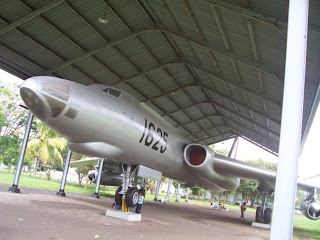 The museum keeps pictures and models of aeroplanes. Some are models of aeroplanes left by Japanese army (which then were used by the Indonesian air-force), the other models are fighting, transportation, and exercise aeroplanes. Please note that visitors have to inform the officer in charge at least one day in advance to visit the museum. The museum is located in the Lanuma Adisucipto complex.
The museum keeps pictures and models of aeroplanes. Some are models of aeroplanes left by Japanese army (which then were used by the Indonesian air-force), the other models are fighting, transportation, and exercise aeroplanes. Please note that visitors have to inform the officer in charge at least one day in advance to visit the museum. The museum is located in the Lanuma Adisucipto complex. The 1200 m long cave was used as a meeting place for teaching Islam in Java. Beside the main cave with a beautiful collection of stalactites and stalagmites you will find some smaller caves. The complex is located in Srunggo, Selopamioro, 22 km from Yogyakarta in the Bantul Regency.
The 1200 m long cave was used as a meeting place for teaching Islam in Java. Beside the main cave with a beautiful collection of stalactites and stalagmites you will find some smaller caves. The complex is located in Srunggo, Selopamioro, 22 km from Yogyakarta in the Bantul Regency. Situated on the eastern outskirts of the city, it has an interesting permanent exhibition of batiks in classic and modern designs The process of batik can also be seen here, both the hand drawn and hand stamped.
Situated on the eastern outskirts of the city, it has an interesting permanent exhibition of batiks in classic and modern designs The process of batik can also be seen here, both the hand drawn and hand stamped. The former home of Ki Hajar Dewantoro (founder of the Taman Siswa Institute, the oldest national education institute), was established in 1932. He was both an educator and a fervent patriot fighting for independence, and a close friend of Rabindranath Tagore (an educational figure from India). The building style, carving, reliefs and the very attractive statues bring the image of harmony and dynamism of Indonesian cultural artwork.
The former home of Ki Hajar Dewantoro (founder of the Taman Siswa Institute, the oldest national education institute), was established in 1932. He was both an educator and a fervent patriot fighting for independence, and a close friend of Rabindranath Tagore (an educational figure from India). The building style, carving, reliefs and the very attractive statues bring the image of harmony and dynamism of Indonesian cultural artwork.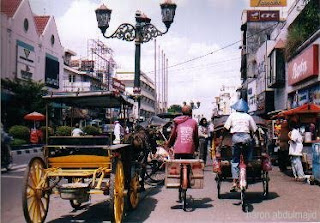 Despite the growing appeal of the new shopping street Jalan Urip Sumoharjo, with its up dated commercial trapping, the vibrant life of the city is still centered along Malioboro and Ahmad Yani street, extending from the railway to the public square facing the Sultan's Palace. The shops open from 9am to 2pm and 6pm to 9pm including Sundays. There are dozens of cozy restaurants with reasonable prices and serving wide selections of dishes.
Despite the growing appeal of the new shopping street Jalan Urip Sumoharjo, with its up dated commercial trapping, the vibrant life of the city is still centered along Malioboro and Ahmad Yani street, extending from the railway to the public square facing the Sultan's Palace. The shops open from 9am to 2pm and 6pm to 9pm including Sundays. There are dozens of cozy restaurants with reasonable prices and serving wide selections of dishes.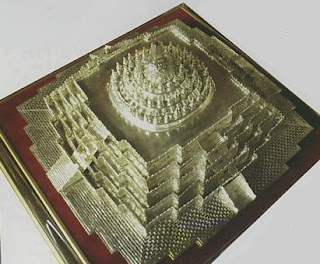 If you are interested in exploring the local silver craft production, it is worth visiting Kota Gede, about 6 km south of Yogyakarta. There are two kinds of silver craft produced: white and black silver. The best is to walk around Kota Gede and visit so as many shops as possible to assess the best place to buy your favoured pieces at reasonable prices.
If you are interested in exploring the local silver craft production, it is worth visiting Kota Gede, about 6 km south of Yogyakarta. There are two kinds of silver craft produced: white and black silver. The best is to walk around Kota Gede and visit so as many shops as possible to assess the best place to buy your favoured pieces at reasonable prices.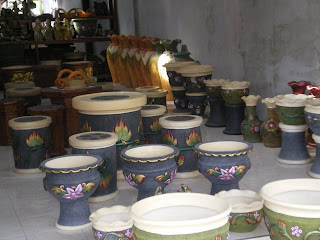 A village 7 km to the south of Yogyakarta, is the number one location for pottery craft as well as earthenware and ceramics. Due the influence of long staying foreigners, the pottery industry these days offers a broad spectrum of pottery items and ceramics, from giant vases to little funny souvenirs.
A village 7 km to the south of Yogyakarta, is the number one location for pottery craft as well as earthenware and ceramics. Due the influence of long staying foreigners, the pottery industry these days offers a broad spectrum of pottery items and ceramics, from giant vases to little funny souvenirs. Shopping in Yogyakarta is like shopping no where else on earth. Here you will find treasures to take home with you that will please you for years to come. Traditional Indonesian arts and crafts are popular as souvenirs. Batik, the oldest traditional Javanese art is done as hand painted or hand-woven fabric. Their usefulness is endless, from a simple beach-wrap, to a baby hammock or future wall hanging or cushion cover. Due the important role of batik painting in the daily life of the people in Central Java, Yogyakarta has plenty of Batik Schools and Colleges. NOTE: These offer batik painting courses for foreigners. Woodcarvings and paintings are easily available. In the smaller shops, bargaining is accepted; however, in larger shops, prices are fixed. The Yogyakarta leather craft industry traditionally uses the hide of water buffaloes, cows and goats. The most famous leather craft product is the Wayang Kulit, the puppet used for the well known Javanese Shadow Play. Beside this, leather is the basic material for producing room decorations, bags, sandals, and souvenirs. Electronics goods are both high quality and inexpensive with all major brands available. Signature 'Prestige' fashion goods are available at very competitive prices.
Shopping in Yogyakarta is like shopping no where else on earth. Here you will find treasures to take home with you that will please you for years to come. Traditional Indonesian arts and crafts are popular as souvenirs. Batik, the oldest traditional Javanese art is done as hand painted or hand-woven fabric. Their usefulness is endless, from a simple beach-wrap, to a baby hammock or future wall hanging or cushion cover. Due the important role of batik painting in the daily life of the people in Central Java, Yogyakarta has plenty of Batik Schools and Colleges. NOTE: These offer batik painting courses for foreigners. Woodcarvings and paintings are easily available. In the smaller shops, bargaining is accepted; however, in larger shops, prices are fixed. The Yogyakarta leather craft industry traditionally uses the hide of water buffaloes, cows and goats. The most famous leather craft product is the Wayang Kulit, the puppet used for the well known Javanese Shadow Play. Beside this, leather is the basic material for producing room decorations, bags, sandals, and souvenirs. Electronics goods are both high quality and inexpensive with all major brands available. Signature 'Prestige' fashion goods are available at very competitive prices.
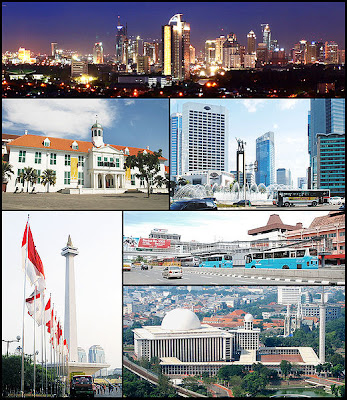
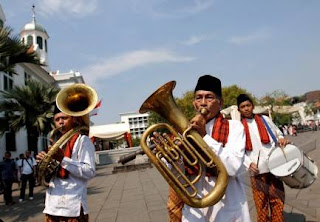 The Betawi (Orang Betawi, or "people of Batavia") is a term used to describe the descendants of the people living in and around Batavia and recognized as an ethnic group from around the 18th-19th century.The Betawi people are mostly descended from various Southeast Asian ethnic groups brought or attracted to Batavia to meet labor needs, and include people from different parts of Indonesia. The language and Betawi culture are distinct from those of the Sundanese or Javanese. The language is mostly based on the East Malay dialect and enriched by loan words from Sundanese, Javanese, Chinese, and Arabic. Nowadays, the Jakarta dialect Bahasa Jakarta) used as a street language by people in Jakarta is loosely based on the Betawi language.
The Betawi (Orang Betawi, or "people of Batavia") is a term used to describe the descendants of the people living in and around Batavia and recognized as an ethnic group from around the 18th-19th century.The Betawi people are mostly descended from various Southeast Asian ethnic groups brought or attracted to Batavia to meet labor needs, and include people from different parts of Indonesia. The language and Betawi culture are distinct from those of the Sundanese or Javanese. The language is mostly based on the East Malay dialect and enriched by loan words from Sundanese, Javanese, Chinese, and Arabic. Nowadays, the Jakarta dialect Bahasa Jakarta) used as a street language by people in Jakarta is loosely based on the Betawi language. Betawi arts are rarely found in Jakarta due to their infamous low-profile and most Betawi have moved to the border of Jakarta, displaced by new immigrants. It is easier to find Java or Minang based wedding ceremonial instead of Betawi weddings in Jakarta. It is easier to find Javanese Gamelan instead of Gambang Kromong (a mixture between Betawi and Chinese music) or Tanjidor (a mixture between Betawi and Portuguese music) or Marawis (a mixture between Betawi and Yaman music). However, some festivals such as the Jalan Jaksa Festival or Kemang Festival include efforts to preserve Betawi arts by inviting artists to give performances.
Betawi arts are rarely found in Jakarta due to their infamous low-profile and most Betawi have moved to the border of Jakarta, displaced by new immigrants. It is easier to find Java or Minang based wedding ceremonial instead of Betawi weddings in Jakarta. It is easier to find Javanese Gamelan instead of Gambang Kromong (a mixture between Betawi and Chinese music) or Tanjidor (a mixture between Betawi and Portuguese music) or Marawis (a mixture between Betawi and Yaman music). However, some festivals such as the Jalan Jaksa Festival or Kemang Festival include efforts to preserve Betawi arts by inviting artists to give performances. This place is miniature of Indonesia, illustrated the diversity of cultures, customs and traditions in Indonesia. Here also there is Museum, please visit
This place is miniature of Indonesia, illustrated the diversity of cultures, customs and traditions in Indonesia. Here also there is Museum, please visit 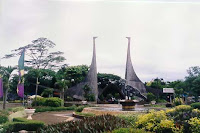 Ragunan zoo is a kind of combination between zoo and park. It has almost 30,000 plants from 250 different kinds of. Since it is a combination between zoo and park, Ragunan Zoo is also known as Ragunan Zoological Park.
Ragunan zoo is a kind of combination between zoo and park. It has almost 30,000 plants from 250 different kinds of. Since it is a combination between zoo and park, Ragunan Zoo is also known as Ragunan Zoological Park. Indonesia National Monument or what Indonesian and Jakarta people usually call as Monas is a monument built to remember the struggle of Indonesian heroes fighting the colonial domination.
Indonesia National Monument or what Indonesian and Jakarta people usually call as Monas is a monument built to remember the struggle of Indonesian heroes fighting the colonial domination.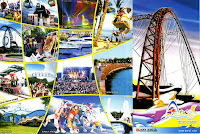 Jaya Ancol Dreamland Park is a recreation area located at the seashore of Jakarta Gulf. Jaya Ancol Dreamland Park is better known as Ancol by most of Indonesian people. There’re several recreation facilities you can find at Jaya Ancol Dreamland Park: Golf Course, Ancol Marina Bay, Art Market (Pasar Seni), Dunia Fantasy, SeaWorld Indonesia, Gelanggang Samudera, Atlantis Water Adventure, andBeach Park (Taman Pantai). Jaya Ancol Dreamland Park provides facilities for those visitors who wants to stay in the Ancol area. Visitors can choose between three hotels and one cottage provided which respectively are Raddin Hotel, Mercure Hotel, Wisata Hotel and Putri Duyung Cottage.
Jaya Ancol Dreamland Park is a recreation area located at the seashore of Jakarta Gulf. Jaya Ancol Dreamland Park is better known as Ancol by most of Indonesian people. There’re several recreation facilities you can find at Jaya Ancol Dreamland Park: Golf Course, Ancol Marina Bay, Art Market (Pasar Seni), Dunia Fantasy, SeaWorld Indonesia, Gelanggang Samudera, Atlantis Water Adventure, andBeach Park (Taman Pantai). Jaya Ancol Dreamland Park provides facilities for those visitors who wants to stay in the Ancol area. Visitors can choose between three hotels and one cottage provided which respectively are Raddin Hotel, Mercure Hotel, Wisata Hotel and Putri Duyung Cottage. The National Museum of Indonesia (Indonesian: Museum Nasional), is an archeological, historical, ethnological, and geographicalmuseum located in Jakarta. Popularly known as Elephant Building (Indonesian: Gedung Gajah) after the elephant statue in its forecourt. Its broad and fascinating collections covers all of Indonesia's territory and almost all of its history. The museum has endeavoured to preserve Indonesia's heritage for two centuries.
The National Museum of Indonesia (Indonesian: Museum Nasional), is an archeological, historical, ethnological, and geographicalmuseum located in Jakarta. Popularly known as Elephant Building (Indonesian: Gedung Gajah) after the elephant statue in its forecourt. Its broad and fascinating collections covers all of Indonesia's territory and almost all of its history. The museum has endeavoured to preserve Indonesia's heritage for two centuries. Kota Tua, Jakarta is an area of Dutch colonization inheritance which was well-known as Batavia in the 17th century. At Kota Tua area you can see old buildings with architecture style influenced by the Dutch or European architecture style, Chinese and even some of them with combination of Dutch and Chinese architecture. Some of the old buildings at Kota Tua area occupied as museums by the governor of DKI Jakarta. Kota Tua is one of a very interesting place or area to visit when you travel toJakarta since it’s a center of historical tourism object in Jakarta.
Kota Tua, Jakarta is an area of Dutch colonization inheritance which was well-known as Batavia in the 17th century. At Kota Tua area you can see old buildings with architecture style influenced by the Dutch or European architecture style, Chinese and even some of them with combination of Dutch and Chinese architecture. Some of the old buildings at Kota Tua area occupied as museums by the governor of DKI Jakarta. Kota Tua is one of a very interesting place or area to visit when you travel toJakarta since it’s a center of historical tourism object in Jakarta. Jakarta History Museum is known as Fatahillah Museum. Jakarta History Museum provides information on Jakarta’s history, starting from the prehistoric age to current age, in a creative way, through the collections of the museum.
Jakarta History Museum is known as Fatahillah Museum. Jakarta History Museum provides information on Jakarta’s history, starting from the prehistoric age to current age, in a creative way, through the collections of the museum. Along Sunda Kelapa Harbor you could see Phinisi ships in a line, which have unique shape and the body painted in some different colors. Phinisi ships were coming from many regions of Indonesia, carrying logs, rattan, copra and other agricultural products to Jakarta. When Phinisi goes back fromJakarta, it carries construction materials like steel and cement. You could see the hectic of loading and unloading activities that is still conducted traditionally at Sunda Kelapa.
Along Sunda Kelapa Harbor you could see Phinisi ships in a line, which have unique shape and the body painted in some different colors. Phinisi ships were coming from many regions of Indonesia, carrying logs, rattan, copra and other agricultural products to Jakarta. When Phinisi goes back fromJakarta, it carries construction materials like steel and cement. You could see the hectic of loading and unloading activities that is still conducted traditionally at Sunda Kelapa.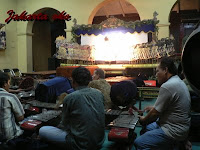 Wayang is a theatrical performance employing puppets or human dancer. The puppet could be made of leather which perform shadow puppets play, or of wooden. Wayang Museum (used to be called as Shadow Puppet Museum as well) is a museum which keeps collections of wayang from various territories in Indonesia and even from other countries. The idea of building Wayang Museum started when H. Ali Sadikin, the governor of DKI Jakarta, attended the second wayang museum week in 1974. With the support of the committee of the wayang museum week, wayang lovers, and the governor of DKI Jakarta, then the building at Jalan Pintu Besar Utara # 27, West Jakarta decided to be Wayang Museum. The museum was officially open on 13th August, 1975 by the governor of DKI Jakarta, H. Ali Sadikin.
Wayang is a theatrical performance employing puppets or human dancer. The puppet could be made of leather which perform shadow puppets play, or of wooden. Wayang Museum (used to be called as Shadow Puppet Museum as well) is a museum which keeps collections of wayang from various territories in Indonesia and even from other countries. The idea of building Wayang Museum started when H. Ali Sadikin, the governor of DKI Jakarta, attended the second wayang museum week in 1974. With the support of the committee of the wayang museum week, wayang lovers, and the governor of DKI Jakarta, then the building at Jalan Pintu Besar Utara # 27, West Jakarta decided to be Wayang Museum. The museum was officially open on 13th August, 1975 by the governor of DKI Jakarta, H. Ali Sadikin.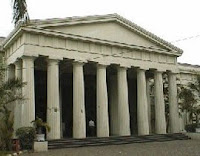 Fine Art and Ceramic Museum presents collections of ndonesian artist works of art from the era of 1800 to the current era. Fine Art and Ceramic Museum occupies a building, named Fine Art Hall. Before it’s occupied as a museum, the hall had been occupied by many organizations and instances from the time of Holland collonialization to the after independence time.
Fine Art and Ceramic Museum presents collections of ndonesian artist works of art from the era of 1800 to the current era. Fine Art and Ceramic Museum occupies a building, named Fine Art Hall. Before it’s occupied as a museum, the hall had been occupied by many organizations and instances from the time of Holland collonialization to the after independence time. Thousand Island lies in the waters of Jakarta Bay which has 100 miles length and 108,000 ha width. There’re about 110 islands, in some large and small group of islands in the Thousand Island. Those islands divided into tourism islands, conservation, historical island, and island for community empowerment in accordance with the characteristics differences between each island.
Thousand Island lies in the waters of Jakarta Bay which has 100 miles length and 108,000 ha width. There’re about 110 islands, in some large and small group of islands in the Thousand Island. Those islands divided into tourism islands, conservation, historical island, and island for community empowerment in accordance with the characteristics differences between each island.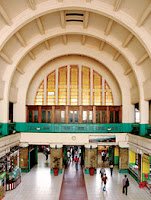 Jakarta Kota Station (also called BEOS by local people) is railway station of the Dutch inheritance. Jakarta Kota Station (BEOS) is located at the area of Kota Tua, Jakarta, and that’s why the name became Jakarta Kota Station. In the Dutch governmental time, Kota Tua Jakarta was well-known as Batavia. At that time Jakarta Kota Station (BEOS) was utilized to connect Batavia City with other areas near to Batavia, such as Bogor and Bandung.
Jakarta Kota Station (also called BEOS by local people) is railway station of the Dutch inheritance. Jakarta Kota Station (BEOS) is located at the area of Kota Tua, Jakarta, and that’s why the name became Jakarta Kota Station. In the Dutch governmental time, Kota Tua Jakarta was well-known as Batavia. At that time Jakarta Kota Station (BEOS) was utilized to connect Batavia City with other areas near to Batavia, such as Bogor and Bandung.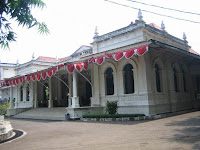 Textile Museum has thousands collections of traditional textiles with various motif and ornaments from each territories in Indonesia. Textile Museum occupies a very artistic and luxurious building. Inside the building there are display rooms used to display Indonesian textiles, including collections of the museum, designer and textile lover’s society. At the back side of the museum’s main building there is natural dye park which functioned to conserve and introduce the plants can be used as natural coloring material to the textile lovers. Even currently the natural dye has been replaced by synthetic color, however the shift in the use of material and tools not reducing the beauty of Indonesian textile.
Textile Museum has thousands collections of traditional textiles with various motif and ornaments from each territories in Indonesia. Textile Museum occupies a very artistic and luxurious building. Inside the building there are display rooms used to display Indonesian textiles, including collections of the museum, designer and textile lover’s society. At the back side of the museum’s main building there is natural dye park which functioned to conserve and introduce the plants can be used as natural coloring material to the textile lovers. Even currently the natural dye has been replaced by synthetic color, however the shift in the use of material and tools not reducing the beauty of Indonesian textile.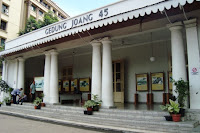 Battle’45 Museum (Museum Joang’45) collects inheritances from the Indonesian independence battle time, that used/worn by Indonesian warriors. Visiting Battle’45 Museum would increase your knowledge and insight about Indonesian journey from the colonization time until finally free and independent.
Battle’45 Museum (Museum Joang’45) collects inheritances from the Indonesian independence battle time, that used/worn by Indonesian warriors. Visiting Battle’45 Museum would increase your knowledge and insight about Indonesian journey from the colonization time until finally free and independent. Maritime Museum presents complete information about Indonesian nautical matters. Maritime Museum occupied two levels of building used as exhibition rooms from the total of three levels of floor in the building. Thes material used on the building dominated by wood. Large windows in the building functioned as ventilation, making the building has a good air circulation.
Maritime Museum presents complete information about Indonesian nautical matters. Maritime Museum occupied two levels of building used as exhibition rooms from the total of three levels of floor in the building. Thes material used on the building dominated by wood. Large windows in the building functioned as ventilation, making the building has a good air circulation.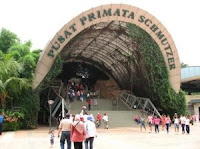 Schmutzer Primate Center is an artificial habitat of primates like gorilla, chimpanzee, orang utan and other kinds of primate. Schmutzer Primate Center is located at Ragunan Zoological Park area. Visitors of Schmutzer Primate Center can observe the behavior and activities of gorilla from a sky cross that was built over the area where gorillas inhabited. The sky cross for observation that’s covered by canopy roof is the main lane that visitors would find once they enter the building. The design of Schmutzer Primate Center was set close to the natural primate habitat with attractive layout of each room. The layout of Schmutzer accommodates the pleasure of primates as inhabitant and visitors who want to see the natural life of primates as in the wild nature.
Schmutzer Primate Center is an artificial habitat of primates like gorilla, chimpanzee, orang utan and other kinds of primate. Schmutzer Primate Center is located at Ragunan Zoological Park area. Visitors of Schmutzer Primate Center can observe the behavior and activities of gorilla from a sky cross that was built over the area where gorillas inhabited. The sky cross for observation that’s covered by canopy roof is the main lane that visitors would find once they enter the building. The design of Schmutzer Primate Center was set close to the natural primate habitat with attractive layout of each room. The layout of Schmutzer accommodates the pleasure of primates as inhabitant and visitors who want to see the natural life of primates as in the wild nature.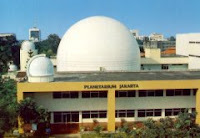 Planetarium Jakarta is an educational touring facility that presents simulations about astronomy and celestial objects. The existence of Planetarium Jakarta is very useful for Indonesian people, especially students, as it's really helpful in developing knowledge about earth and outer space science. The At Planetarium Jakarta you could see Planetarium Show, usually called as Star Theater. The show takes about 60 minutes time with various themes such as Solar System, Solar Eclipse and Lunar Eclipse, Little Explorer at Solar System, Our Galaxy is Bima Sakti, Earth, the Blue Planet, Multi Star and Variable Star, From Equator to Polar, Biography of the Star, and The Formation of Solar System. Besides the Star Theater show there’s also a multimedia show that explain the theories about solar as the center of solar system and the theories about the formation of universe.
Planetarium Jakarta is an educational touring facility that presents simulations about astronomy and celestial objects. The existence of Planetarium Jakarta is very useful for Indonesian people, especially students, as it's really helpful in developing knowledge about earth and outer space science. The At Planetarium Jakarta you could see Planetarium Show, usually called as Star Theater. The show takes about 60 minutes time with various themes such as Solar System, Solar Eclipse and Lunar Eclipse, Little Explorer at Solar System, Our Galaxy is Bima Sakti, Earth, the Blue Planet, Multi Star and Variable Star, From Equator to Polar, Biography of the Star, and The Formation of Solar System. Besides the Star Theater show there’s also a multimedia show that explain the theories about solar as the center of solar system and the theories about the formation of universe. Inscriptions Museum occupies a culture preserve building, an inheritance building from the colonial time. It was formerly a funeral park of Dutch and European people which than restored and modified to be Inscription Museum with the collections located at the open air area. The collections are located at a 1.2 hectares area, and for it Inscription Museum is also called as Inscription Park. Inscription Museum exhibits selected gravestone inscriptions from the historical relic and work of arts from the past that combined the work of sculptor, carver, calligrapher, and man of letters.
Inscriptions Museum occupies a culture preserve building, an inheritance building from the colonial time. It was formerly a funeral park of Dutch and European people which than restored and modified to be Inscription Museum with the collections located at the open air area. The collections are located at a 1.2 hectares area, and for it Inscription Museum is also called as Inscription Park. Inscription Museum exhibits selected gravestone inscriptions from the historical relic and work of arts from the past that combined the work of sculptor, carver, calligrapher, and man of letters.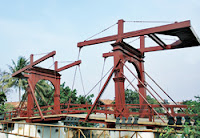 Kota Intan Bridge was constructed in the 17th century by the Dutch government to connect the West Kali Besar and East Kali Besar. Kota Intan Bridge located at Kota Tua Jakarta which was known as Batavia on the time of Duta colonial. Kota Intan Bridge was made of wood and equipped with leverage to get the lower side of the bridge up when there was ship or boat passed by. In the Dutch colonial time the ships which deliver spicy from hinterland to the warehouse would pass by Kota Intan Bridge.
Kota Intan Bridge was constructed in the 17th century by the Dutch government to connect the West Kali Besar and East Kali Besar. Kota Intan Bridge located at Kota Tua Jakarta which was known as Batavia on the time of Duta colonial. Kota Intan Bridge was made of wood and equipped with leverage to get the lower side of the bridge up when there was ship or boat passed by. In the Dutch colonial time the ships which deliver spicy from hinterland to the warehouse would pass by Kota Intan Bridge. Syahbandar Tower is located at the side of Jakarta Gulf Beach, next to the Maritime Museum and Sunda Kelapa Harbor. The current building of Maritime Museum was previously occupied as VOC’s (Vereenigde Oostindische Compagnie) spicy warehouse. VOC was a Dutch company which managed the trading activities on both sea and land for the interest of Nederland. Nederland constructed Syahbandar Tower to guide the traffic of ships that was coming for spicy trading at Sunda Kelapa Harbor.
Syahbandar Tower is located at the side of Jakarta Gulf Beach, next to the Maritime Museum and Sunda Kelapa Harbor. The current building of Maritime Museum was previously occupied as VOC’s (Vereenigde Oostindische Compagnie) spicy warehouse. VOC was a Dutch company which managed the trading activities on both sea and land for the interest of Nederland. Nederland constructed Syahbandar Tower to guide the traffic of ships that was coming for spicy trading at Sunda Kelapa Harbor.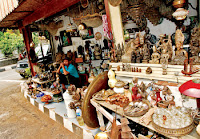 Jalan Surabaya is well known for the antiques market located there. Jalan Surabaya itself is located at Menteng area, at the Central of Jakarta. You can see kiosks/shops that sell antiques like wayang, porcelain, wooden sculptures, mask, eating stuffs made of silver and brass, antique lamp, metal souvenirs, old fashion ornaments, old telephon, old carema, old woven cloth, phonograph record, and some others. One of the kiosks there is selling antiques of ship stuffs like ship rudder, compass, telescope, and old diving stuffs. At the antique markets at Jalan Surabaya, there’re some kiosk that specialized on selling bags and suitcases. There’re also kiosks that sell old books.
Jalan Surabaya is well known for the antiques market located there. Jalan Surabaya itself is located at Menteng area, at the Central of Jakarta. You can see kiosks/shops that sell antiques like wayang, porcelain, wooden sculptures, mask, eating stuffs made of silver and brass, antique lamp, metal souvenirs, old fashion ornaments, old telephon, old carema, old woven cloth, phonograph record, and some others. One of the kiosks there is selling antiques of ship stuffs like ship rudder, compass, telescope, and old diving stuffs. At the antique markets at Jalan Surabaya, there’re some kiosk that specialized on selling bags and suitcases. There’re also kiosks that sell old books.